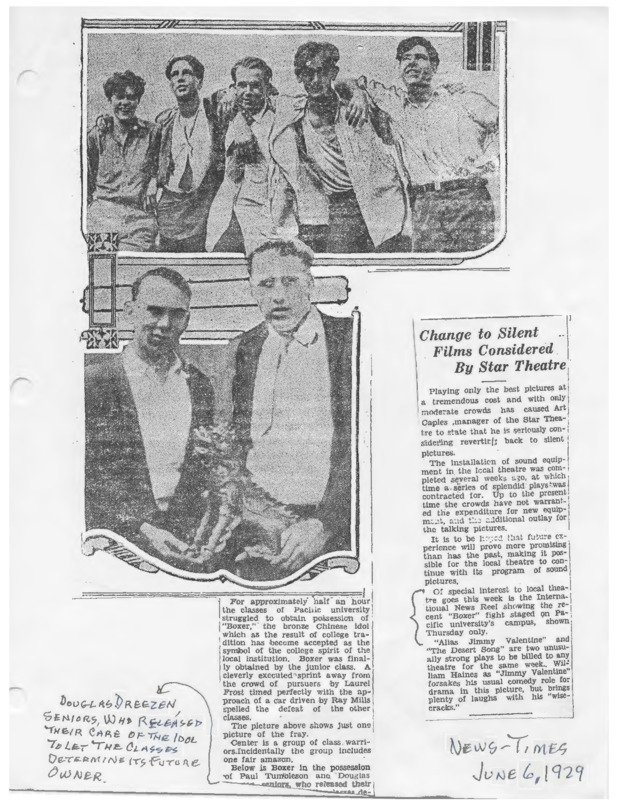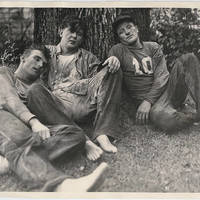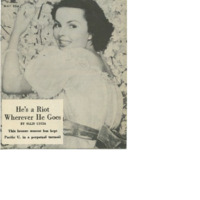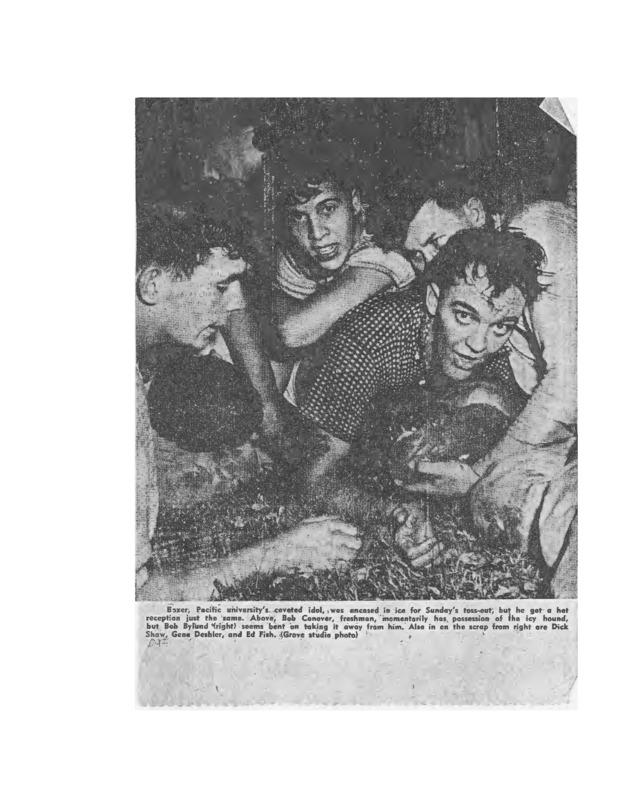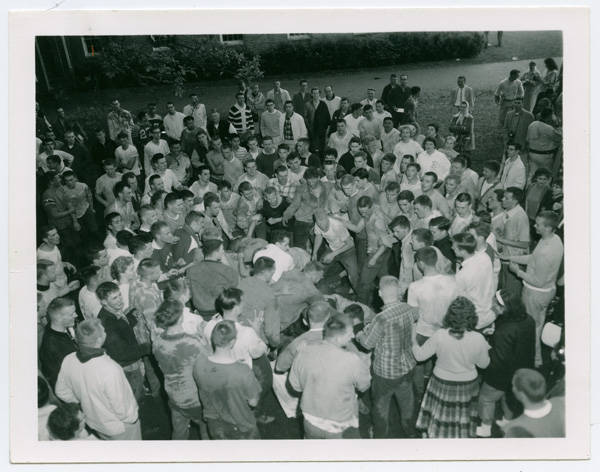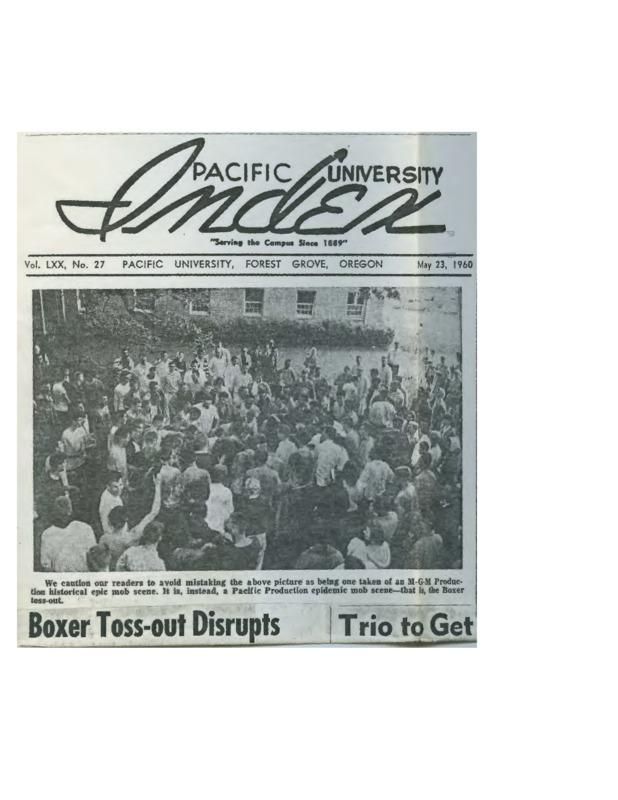What was a "Boxer Toss"?
From the very beginning of the Boxer tradition, students wanted the honor of holding the statue. Once in possession of Boxer, they kept his location secret. Students might briefly "flash" Boxer to show him off, but they would always put the statue back into a secure hiding place soon afterwards. When the students who held Boxer graduated though, they had to give it back to the current student body so that the tradition could continue.
This raised the question: Which group of students deserved the honor of holding Boxer next?
By the 1920s, students had accidentally invented an answer. First, an announcement or a rumor would be started that Boxer would soon make an appearance on campus. Because no single person could hope to grab the statue alone, students would form teams to wrestle the statue away from competitors. In the early days, these teams were based on class years. For example, all the sophomore men or all the junior men would join together to fight for Boxer. In later decades, fraternities like Gamma Sigma, Alpha Zeta or Phi Beta Tau formed the backbone of each team.
When the rumored day of Boxer's appearance arrived, a representative of the group that had most recently held the statue would suddenly appear somewhere on campus. A shout would go out: "BOXER!!!" Then, the Boxer statue would be "tossed" out into the open. The assembled teams would rush forward to grab the statue. An all-out brawl usually followed. Dozens or hundreds of students -- mostly men, though some women also fought -- would range all over campus and the surrounding blocks, fighting over the statue. Frequently, the fight was so violent that pieces of Boxer would be broken off, while participants suffered broken bones or concussions. When one group finally gained control, they would whisk the statue away in a waiting vehicle. On a few occasions, dangerous high-speed car chases continued the battle.
The Boxer Toss became so notorious that it sometimes made the evening news or was covered in national magazines. For many students, it was a defining experience of their college years.
Several tosses live on in infamy: like the time Boxer was tossed while frozen into a block of ice (1956); or dangled from a tall tree (1949); or tossed out from the trunk of a car in the middle of Trombley Square (1968; see video above).
An account of one such toss in 1960 illustrates the chaos:
At exactly 12:20 p.m., a Jeep roared across campus to the walk in front of Warner Hall and screeched to a stop as Bob Wendel, ex-co-owner of Boxer tossed out the little bronze dog which landed on the grass, flipped over and came to a momentary rest before a crowd surged forward and pounced on him. The three hour and thirty-five minute battle which ensued was confined primarily to his same area south of Warner Hall although it did move completely off campus after two hours had elapsed. [...] Suspense heightened as the pulsating mass moved around the west end of Warner across the pavement to a filling station, then poured into the street in front of the fire department. The multitude immediately scattered as Don Printz, clutching one of Boxer's front legs, and Doug Steward, both Phi Betes, raced down the highway in front of the fire department, across the railroad tracks and safely reached a get-away car. Those who had the rest of Boxer surged across the highway into the parking lot followed by an ever-increasing crowd which inched its way along the parking lot, out into the street, into the parking lot again and finally on to the tracks. [...] Finally, Tod Johnson, AZ, managed to free himself from the clutching crowd and ran with Boxer through the alley by the police station. He threw the bronze idol to Paul Thompson [...]. Shortly before he reached the car, Thompson threw the dog to independent Ron Eastwood who was running along beside him with instructions to put it in La Rue's car. [... The account continues, noting that Boxer's other leg and one ear were also broken off in the fight.]Of the thirteen students who came to the infirmary for first aid only two had to have stitches. Two received treatment for broken hands and two were released after being examined by a doctor for possible brain concussions. One student suffered a dislocated nose, another received a sprained ankle and one co-ed rebroke her little finger.
It is very lucky that no one was ever killed during one of these tosses. Their violence may have been a contributing factor to the original Boxer statue's 55-year disappearance from public view in 1969. As many young people were protesting the Vietnam War, some students felt that encouraging such a fight on campus was wrong, or at the very least, irresponsible. By the time Boxer II was cast in the early 1980s, students and faculty were much more aware of the dangers and they worked together to discourage violence. The Pacific University administration has officially opposed the "toss" tradition since the 1980s. The last known Toss -- a dialed-down version of the older tradition -- is believed to have occurred sometime in the mid-2000s with Boxer II.
